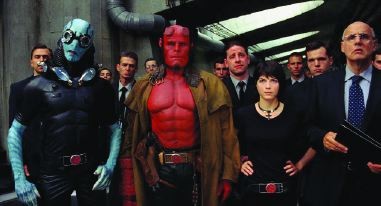Hellboy II: The GoldenArmy

The makers of Hellboy II: The Golden Army must have had the time of their lives. The director, Guillermo del Toro, and his team of set, costume and special-effects designers provide a cornucopia of visual splendors.
The movie is a fairy tale that pits Hellboy (Ron Perlman) and his superhero pals Abe Sapien (Doug Jones), who is half-man, half-amphibian, and Liz Sherman (Selma Blair), Hellboy’s lover, against Nuada (Luke Goss), an elf prince who wants to break the peace between humankind and the supernatural creatures that occupy a world beyond ours. And though the movie is a sequel (the first Hellboy chronicled the character’s origins and developed him as a crime fighter), you don’t need to have seen the original to enjoy this one, which is in any case a vast improvement. Hellboy had a wonderful opening (the birth of the title character), but nothing that followed lived up to it; its story line felt overly familiar, and Perlman, game actor though he is, lacked the expressive range to carry the picture.
This movie is helped by the division of labor among the cast, which includes Jeffrey Tambor as the federal agent in charge of the superheroes and Anna Walton as the prince’s pristine, woebegone twin sister (whom Abe falls in love with). And since he made Hellboy, del Toro has become a far more accomplished moviemaker.
In his previous picture, the astonishing Pan’s Labyrinth, the human and supernatural worlds also intersected, but in that film the realm of fairies and monsters was a metaphor for the resources that the heroine drew on amid the terrors of wartime. In Hellboy II flamboyant fantasy scenarios are purely for the sake of entertainment.
Though the plot is more than serviceable, it’s just an excuse for a series of magnificent episodes populated by creatures as inventive and funny as any you’ve ever seen in a screen fantasy. Del Toro layers these on top of our memories of other movies, calling up images and ideas that we recognize and then ringing changes on them. The celebrated space saloon from Star Wars, for example, inspires a marvelous trolls’ market where Hellboy and his friends seek clues to the whereabouts of Prince Nuada. Among the creatures the prince liberates is one that burst up through the city pavement, like the aliens in The War of the Worlds. Not all the allusions are to fantasy adventures: Johann Krauss (voiced by Seth MacFarlane), the new supervisor sent by the FBI, is a robot with a version of Dr. Strangelove’s German accent.
Nuada, an albino with a mane of white hair, aims to summon up the ghostly Golden Army to defeat the world of humans. His enmity for humankind derives from a conviction that humans have wrecked the beauty of the ancient, magical world; he even tries to enlist Hellboy as an ally, arguing that he belongs to the old world himself and has chosen the wrong side to fight on. Though Nuada is a ruthless villain, visually the movie supports his case, with wonders such as the gargantuan Wink, who has a detachable lethal arm, and tooth fairies, insatiable tiny creatures that attack their prey’s teeth first.
Countering this plea for a return to the purity of ancient magic, however, is the fact that Hellboy II derives much of its humor from the interplay of the fantastical and the everyday. The film makes us privy to the complaints of a variety of creatures, and their grousing brings them down to earth. In one hilarious scene Hellboy and Abe, each nursing a broken heart, get plastered on beer and play Barry Manilow music. Like other memorable fantasies—The Wizard of Oz comes to mind—Hellboy II combines phantasmagoria with vaudeville. The mix-and-match makes for undiluted pleasure.





